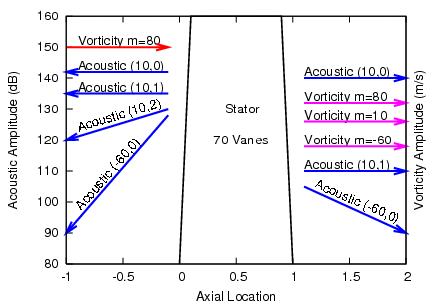
Jet Engine Noise
The reduction of jet engine noise is an important goal for aircraft manufacturers. One of the main components of jet engine noise is tonal noise from the interaction of rotating wakes with downstream blade rows. Tonal noise occurs at discrete frequencies (multiples of the blade passing frequency) and can be analyzed by linearized flow methods.
Acoustic Modes
The interaction of rotating wakes with downstream blade rows generates acoustic modes (unsteady pressure waves) that propagate up and and down the jet engine. The amplitudes of most of these acoustic modes decay rapidly (cut-off), however, some acoustic modes may not decay (cut-on). It is important to accurately predict the amplitude and shape of the cut-on and nearly cut-on acoustic modes to evaluate the acoustic behaviour of a jet engine.
Three-Dimensional Non-Reflecting Boundary Condition
RPMTurbo has developed an exact three-dimensional non-reflecting boundary condition for steady and unsteady flow simulations. This boundary condition calculates the unsteady aerodynamic modes (which include acoustic modes) at the inlet and outlet of each row. The modes are determined numerically by solving an eigen problem for the semi-discretized flow equations on a two-dimensional mesh. Unlike previous methods, this method is valid for non-uniform swirling steady flow. The application of the three-dimensional non-reflecting boundary condition is very important for acoustic analysis because the individual acoustic modes can be easily identified. The boundary condition also prevents non-physical reflections at the inlet and outlet which can reduce the accuracy of the linearized flow simulations.
The three-dimensional non-reflecting boundary condition is also important for determining the correct amplitude and shape of the incoming vorticity and acoustic (potential) modes. The boundary condition is applied to the steady flow simulation of the upstream row in steady mode (frequency = 0). This is particularly important for short computational domains where the location of the inlet and outlet planes are close to the leading and trailing edges of the blade.
Wave Plots
RPMTurbo performs three-dimensional unsteady linearized flow simulations to predict the amplitude of the acoustic modes generated by the interaction of a wake with a downstream row. The results from linearized flow simulations can be represented by a wave plot. The wave plot below shows the amplitude of the outgoing acoustic and vorticity modes generated by an incoming vorticity wave (wake). The incoming wave has 80 nodal diameters which corresponds to the number of blades of the upstream row.

Multi-Row and Multi-Frequency Analysis
The acoustic modes generated by the wake-row interaction can travel up or down stream. These acoustic modes will interact with other rows and these secondary interactions can be significant. In this case, a multi-row analysis is necessary. Also, the reflected and transmitted acoustic modes can be scattered. Scattered modes have a different nodal diameter and as a result, the modes are reflected and transmitted at a different frequency. RPMTurbo can perform multi-row and multi-frequency acoustic analyzes.
Test Cases
RPMTurbo's acoustic analysis has been validated by examining an internationally recognized acoustic test case.